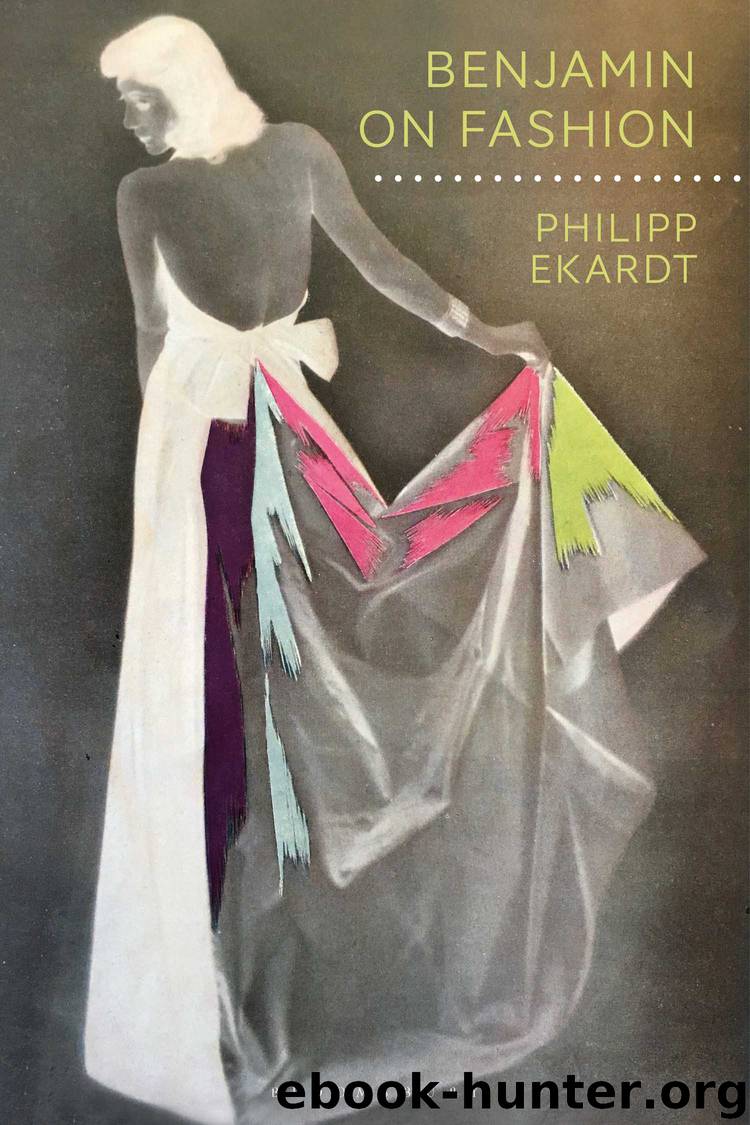Benjamin on Fashion by Philipp Ekardt;

Author:Philipp Ekardt; [Ekardt, Philipp]
Language: eng
Format: epub
ISBN: 9781350076006
Publisher: Bloomsbury UK
Published: 2019-12-12T00:00:00+00:00
Taking it to the industry
Grund’s analysis of fashionable elegance has, finally, a surprising counterpart in her reflections on a number of commercial and production-related aspects of the fashion industry. In these she departs from a number of commercial failures, which the houses of Chanel and Lanvin allegedly suffered when they entered the field of textile manufacturing: “It has never been to their benefit when Parisian fashion creators surrender to the temptation of taking over the fabrication of textiles themselves. Chanel and Lanvin have lost a lot of money in such endeavors” (Es hat noch keinem pariser Modeschöpfer gut getan, wenn er sich verlocken ließ, die Stofffabrikation selbst zu übernehmen. Chanel und Lanvin haben viel Geld dabei verloren.)22 Grund argues that the functional differentiation of the fabrication of textiles and the design and production of dresses benefits both parties’ performances: “To produce textiles ‘in the spirit of fashion’, encompassing the full risk of such explorations, motivates peak performances among the manufacturers” (Die Stoffe im ‘Geiste’ der Mode zu fabrizieren, mit all dem Risiko, das solch ein Voraustasten in sich schließt – das regt die Stoffabrikanten zu Höchstleistungen an), and: “To receive textiles as ‘raw material,’ which to engage with, sparks the imaginations of the fashion tailor” (Die Stoffe als “Rohmaterial” geliefert zu bekommen, mit dem man sich auseinanderzusetzen hat, das beflügelt die Phantasie der Modeschneider).23 One final point leads back to Grund’s theory of elegance: “In general such an engagement [Auseinandersetzung] with the material is necessary in order to supersede [überwinden] its materiality (Im Allgemeinen ist eine Auseinandersetzung mit Material nötig, um seine ‘Stofflichkeit’ zu überwinden).24 In Grund’s story—which, incidentally, has a correlate not just in the realm of the grand fashion houses but also on the pages of the period’s press, where titles such as Vogue, Harper’s, or Femina regularly included illustrations of and short reports about new textiles—the Parisian woman celebrates her fashionable victories because she masters (beherrscht) the raw material (das Rohmaterial) through composition (indem sie es komponiert), thereby executing the elegant working through and animation of materiality which Grund demands.25 This the expert also recognizes on the level of the fashion industry, where the textile suppliers produce cloth, which the couturiers in the production of their own creations “work through” once again.
Grund situates her development of the aesthetic value of fashionable elegance only in the broadest terms. While she provides systematic arguments, she doesn’t furnish references to positions in the history of aesthetics, or criticism. And while she clearly identifies Paris, and with it France, as the cultural center for the production of elegance (offsetting these further in her text against a number of German fashion brands), she is at her most specific in her discussion of the commercial failures of the houses of Lanvin and Chanel in the field of textile production. It is thus perhaps interesting to note that her advocacy for the fashion value of elegance, and her functional definition of it as an immanent animation of materiality, corresponds with a number of positions in the historical poetics of fashion that were contemporaneous with the writing of her text.
Download
This site does not store any files on its server. We only index and link to content provided by other sites. Please contact the content providers to delete copyright contents if any and email us, we'll remove relevant links or contents immediately.
| Advertising | Annuals |
| Book Design | Branding & Logo Design |
| Fashion Design | Illustration |
| Science Illustration |
Wonder by R.J. Palacio(8276)
Unlabel: Selling You Without Selling Out by Marc Ecko(3478)
Mastering Adobe Animate 2023 - Third Edition by Joseph Labrecque(3450)
Ogilvy on Advertising by David Ogilvy(3353)
Hidden Persuasion: 33 psychological influence techniques in advertising by Marc Andrews & Matthijs van Leeuwen & Rick van Baaren(3306)
Drawing Cutting Edge Anatomy by Christopher Hart(3301)
POP by Steven Heller(3232)
The Pixar Touch by David A. Price(3225)
The Code Book by Simon Singh(2872)
The Art of War Visualized by Jessica Hagy(2845)
Slugfest by Reed Tucker(2809)
The Curated Closet by Anuschka Rees(2808)
Rapid Viz: A New Method for the Rapid Visualization of Ideas by Kurt Hanks & Larry Belliston(2733)
Stacked Decks by The Rotenberg Collection(2699)
The Wardrobe Wakeup by Lois Joy Johnson(2644)
365 Days of Wonder by R.J. Palacio(2630)
Keep Going by Austin Kleon(2600)
Tell Me More by Kelly Corrigan(2525)
Tattoo Art by Doralba Picerno(2497)
